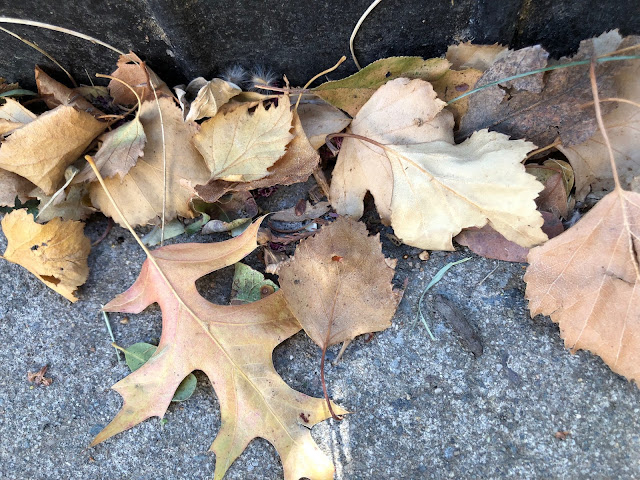
Brown foliage needed for compost, too

|
|
With extra help from the strong winds recently, leaves are starting to accumulate.
Use them for mulch or compost. (Photos: Kathy Morrison)
|
There’s a reason they call it “fall.”
Recent windy conditions brought down an avalanche of leaves in my yard – the first big dump of autumn. With every gust, more leaves rained down, coating the patio with a blanket of gold and brown.
I know I’m not the only one in the City of Trees with this annual dilemma: What to do with all those leaves?
Start by thinking like Mother Nature. It’s not a mess – it’s mulch!
Trees drop leaves, in part, to keep their roots cozy in winter. The fallen foliage also replenishes nutrients in the soil.
Dropped leaves on the patio aren’t doing my trees any good. But as mulch or compost, those cast-off leaves will benefit the trees and the rest of my garden, too.
Smaller leaves, such as birch, pistache or elm, make excellent mulch as is; just rake and place 2 to 3 inches deep around trees and shrubs.
Or chop larger leaves with a lawn mower (a couple of passes usually is sufficient) and use as mulch. It will last through the winter, keeping down weeds while retaining even soil moisture. Some waxy leaves, such as magnolia, may take several seasons to break down.
One note on turning fall foliage into mulch: Don’t use any diseased leaves. If the foliage is showing signs of mildew or other fungal disease or pests, discard it in the trash – not the green waste or your garden. Otherwise, you’re recycling problems along with the leaves.

|
|
Fallen redwood needles can be used as mulch for azaleas
or camellias.
|
Although they’re evergreens, coastal redwoods are susceptible to drought. Those browned needles are signs of stress. Consider having an arborist check the tree’s health.
Meanwhile, those browned needles make durable mulch, especially for acid-loving shrubs such as azaleas or camellias.
Add fall leaves to your compost pile, too. Plus save some for later.
Dried leaves are a necessary ingredient in compost. To promote rapid breakdown in compost, an even amount of “browns” (dried leaves, straw or other dry ingredients) are mixed with “greens,” such as freshly cut grass, spent vegetable plants or kitchen waste.
While dried leaves are plentiful now, come spring they’ll be in short supply. So, bag up some brown leaves to add to your compost pile in March or April to keep it “cooking.”
Comments
0 comments have been posted.Sacramento Digs Gardening to your inbox.
Sites We Like
Garden Checklist for week of July 21
Your garden needs you!
* Keep your vegetable garden watered, mulched and weeded. Water before 8 a.m. to reduce the chance of fungal infection and to conserve moisture.
* Feed vegetable plants bone meal, rock phosphate or other fertilizers high in phosphate to stimulate more blooms and fruiting. (But wait until daily high temperatures drop out of the 100s.)
* Don’t let tomatoes wilt or dry out completely. Give tomatoes a deep watering two to three times a week.
* Harvest vegetables promptly to encourage plants to produce more. Squash especially tends to grow rapidly in hot weather. Keep an eye on zucchini.
* Pinch back chrysanthemums for bushy plants and more flowers in September.
* Remove spent flowers from roses, daylilies and other bloomers as they finish flowering.
* Pinch off blooms from basil so the plant will grow more leaves.
* Cut back lavender after flowering to promote a second bloom.
* It's not too late to add a splash of color. Plant petunias, snapdragons, zinnias and marigolds.
* From seed, plant corn, pumpkins, radishes, winter squash and sunflowers.